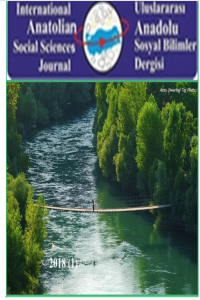ANTİK KAYNAKLAR IŞIĞINDA RUH KAVRAMI VE KHARON
THE CONCEPT OF THE SOUL AND CHARON IN THE LIGHT OF ANCIENT SOURCES
___
- Referans1 Ataç, Nurullah (1944). Samsatlı Lukianos. Seçme Yazılar I. Ankara: Maarif Matbaası.
- Referans2 Ataç, Nurullah (1949). Samsatlı Lukianos. Seçme Yazılar III. İstanbul: Milli Eğitim Basımevi.
- Referans3 Atatürk, Mustafa Kemal (1934). Nutuk. Cilt: II. 1920-1927. İstanbul: Devlet Matbaası.
- Referans4 Bernardakis, Gregorius N. (1893). Plutarchi Chaeronensis Moralia. Vol. V. Leipzig: Teubner.
- Referans5 Brown, P. Michael (1997). Lucretius, De Rerum Natura III. With An Introduction, Text, Translation and Commentary. İngiltere: Aris & Phillips Ltd.
- Referans6 Capelle, Wilhelm (1995). Sokrates’ten Önce Felsefe II. Çev. O. Özügül. İstanbul: Kabalcı Yayınevi.
- Referans7 Conacher, D. J. (1988). Euripides. Alcestis. Edited with Translation and Commentary. İngiltere: Aris & Phillips Ltd.
- Referans8 Conte, Gian Biagio (2009). P. Vergilius Maro. Aeneis. Recensuit Atque Apparatu Critico Instruxit. Berlin: Walter de Gruyter.
- Referans9 Coşkun Abuagla, Asuman (2019). Dönüşümler I-XV. Ed. D. Önder. İstanbul: Yapı Kredi Yayınları.
- Referans10 Diez De Velasco, Francisco (2017). Cuerpos imaginarios: poder y descorporeización en el paso al más allá imaginado en las lécitos áticas de fondo blanco. Res Publica (Madrid), 20 (3). 493-506.
- Referans11 Diez De Velasco, Francisco (2010). El Mediador Fantasma: Mediaciones Simbólicas En El Imaginario Ateniense Clásico Del Tránsito Al Más Allá. 181-218. Şurada: Mediadores y mediación con lo divino en el Mediterráneo antiguo. Ed. M. L. Sánchez León. Palma de Mallorca.
- Referans12 Diez De Velasco, Francisco (1989). La iconografía griega de Caronte: un análisis puntual del LIMC. Gerión Revista de Historia Antigua 7. 297-322.
- Referans13 Dindorfius, Ludovicus. (1869). Ioannis Zonarae Epitome Historiarum. Bibliotheca Scriptorum Graecorum et Romanorum Teubneriana. Leipzig: Teubner.
- Referans14 Dover, Kenneth (1993). Frogs. Edited with Introduction and Commentary. Oxford: Clarendon Press.
- Referans15 Engin, Ali Osman – Calapoğlu, Mustafa – Seven, Mehmet Ali – Yörük, A. Kadir (2008). “Davranışlarımızın Genetik ve Çevresel Boyutları”. Kafkas Üniversitesi Fen Bil Dergi 1 (2): 37-56.
- Referans16 Erdoğan, Murat – Kavukçuer, Yudum – Çetinkaya, Tuğçe (2017). “Türkiye’de Yaşayan Suriyeli Mültecilere Yönelik Medya Algısı”. Özgürlük Araştırmaları Derneği, Liberal Perspektif: Analiz. Sayı: 5. 1-26.
- Referans17 Finamore, John F. – Dillon, John M. (2002). Iamblikhos. De Anima. Text, Translation, and Commentary. Philosophia Antiqua, A Series of Studies on Ancient Philosophy, Vol. 92. Leiden, Boston, Köln: Brill.
- Referans18 Fowler, Harold North (2005). Plato. Euthyphro, Apology, Crito, Phaedo, Phaedrus. With an English Translation. Introduciton by W.R.M. Lamb. Cambridge: Harvard University Press.
- Referans19 Francis, Edward J. Valpy (1860). Ψυχή. The Etymology of The Words of The Greek Language. Longman, Green, Longman, and Roberts. 1-192. Londra.
- Referans20 Găzdac, Ágnes Alföldy – Găzdac, Cristian (2013). “„Who pays the Ferryman?“ The Testimony of Ancient Sources on the Myth of Charon”. Klio 95-2: 285-314.
- Referans21 Giudici, Vittorio (1998). The Sistine Chapel, Its History and Masterpieces. Text: V. Giudici – Illustrations: L. R. Galante. Çev. Anthony Brierley. New York: Peter Bedrick Books.
- Referans22 Erhat, Azra – Kadir, A. (1993). Homeros İlyada. İstanbul: Can Yayınları.
- Referans23 Erhat, Azra – Kadir, A. (1996). Homeros Odysseia. İstanbul: Can Yayınları.
- Referans24 Kinkel, Godofredus (1877). Epicorum Graecorum Fragmenta. Vol. I. Leipzig: Teubner.
- Referans25 Klotz, Reinholdi (1835). M. Tulli Ciceronis Disputationes Tusculanae. Ex Emendatione. Leipzig: Teubner.
- Referans26 Lattimore, Richmond (1962). Themes In Greek And Latin Epitaphs. Amerika: University of Illionis Press.
- Referans27 Leonard, William Ellery (1908). The Fragment of Empedocles (Greek-English). Chicago: The Open Court Publishing Company.
- Referans28 Oakley, John H. (2004). Picturing Greek Death in Classical Athens. Cambridge: Cambridge University Press.
- Referans29 Postgate, John Percival. (1921). Tibullus. Londra: William Heinemann New York: G. P. Putnam’s Sons.
- Referans30 Robert, Carl (1892). Die Nekyia Des Polygnot. Halle: Max Niemeyer.
- Referans31 Rohde, Erwin (1925). Psyche, The Cult of Souls and Belief in Immortality among the Greeks. Çev. W. B. Hillis. Londra: New York, Harcourt, Brace & Company.
- Referans32 Sourvinou-Inwood, Christiane (1986). “Charon”. Lexicon Iconographicum Mythologiae Classicae III. 210-215.
- Referans33 Sourvinou-Inwood, Christiane (1996). ‘Reading’ Greek Death To the End of the Classical Period. Oxford: Clarendon Press.
- Referans34 Stolpe, Jan (2001). Platon. Menon/ Protagoras/ Lysis/ Charmides/ Ion/ Menexenos/ Euthydemos/ Faidros/ Kratylos. Skrifter. Bok 2. Berlin: Atlantis Väljer ur Världslitteraturen.
- Referans35 Vermeule, Emily (1981). Aspects of Death in Early Greek Art and Poetry. Londra: University of California Press.
- Başlangıç: 2017
- Yayıncı: Yusuf ARSLAN
BALTHUS’UN “KEDİLİ KIZ” ADLI ESERİ BAĞLAMINDA BATI RESİM SANATINDA CİNSELLİK OLGUSUNA KISA BİR BAKIŞ
GERİ DÖNÜŞÜMÜN PLANLANMIŞ DAVRANIŞ TEORİSİ İLE AÇIKLANMASI: İNÖNÜ ÜNİVERSİTESİ ÖRNEĞİ
Ayşe GÜL SAVAŞKAN, Şule EKİNCİ, Kahraman ÇATI
II. ABDÜLHAMİD DEVRİNDE ANA-ÇOCUK SAĞLIĞI KİTAPLARI
Zerrin BÖLÜKBAŞI MACİT, Sema FENAR, Esin Fulya ÖZER
6. SINIF ÖĞRENCİLERİNİN ONDALIK GÖSTERİMLERLE TEMSİL VE PROBLEM ÇÖZME BECERİLERİ ARASINDAKİ İLİŞKİ
TAMAMLAYICILIK KURUMU OLARAK VAKIFLAR VE LONCALAR
ANTİK KAYNAKLAR IŞIĞINDA RUH KAVRAMI VE KHARON
KLASİK TÜRK ŞİİRİNDE MAZMUNLAŞAN MEKANLAR: PUTHANELER
ÇOCUK KİTAPLARINDA YANSIMA, İKİLEME VE PEKİŞTİRME SÖZCÜK GÖRÜNÜMLERİ
İlker AYDIN, Ayfer ÖKSÜZ, Ahmet ÇELEBİ
